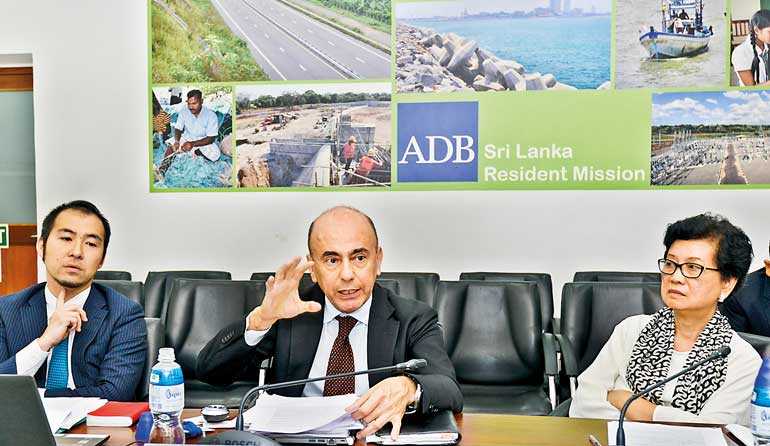Monday Dec 08, 2025
Monday Dec 08, 2025
Monday, 4 March 2019 00:30 - - {{hitsCtrl.values.hits}}

ADB commends SL banks for achieving MSME lending targets
NPLs under the credit lines are below industry average as banks performing well, ADB believes banks can continue to lend to MSMEs in future via its own balance sheets
ADB wins bid to disburse $12.5 million multilateral grant exclusively to develop female entrepreneurs in SL
Limited access to finance, lack of financial literacy, infrastructure, low economic participation of are key constrains in supporting MSMEs in SL
By Charumini de Silva
Following the successful disbursement of $100 million financial intermediation loan to uplift micro, small and medium enterprises (MSMEs) in Sri Lanka, the Asian Development Bank (ADB) said that its innovative approach in effectively implementing the project has achieved the intended objective with banks having overshot targets.
“At first, we set some targets because there was no previous data, and we later revised those targets. Results have been very positive in terms of development impact. The original loan facility of $100 million approved in the latter part of 2016 was fully disbursed over two and half years to over 1,700 MSMEs with exceeding targets of its first time borrowers and women borrowers,” ADB Public Management, Financial Sector and Trade Division – South Asia Department Financial Sector Specialist Takuya Hoshino told journalists in Colombo on Thursday.
Considering the importance of economic growth and job creation in Sri Lanka, the ADB approved an additional $75 million financing for the MSME line of credit project to increase the available loans for 10 participating banks to $175 million by 2020, from the original loan figure of $100 million approved in February 2016. The program has included a $2 million technical assistance grant project supported by the Japan Fund for Poverty Reduction to train the MSMEs on good business practices.
According to the ADB, Sri Lankan banks have overshot lending targets to MSMEs credit program to avoid penalties and falling behind competitors, prompting the lender to increasing funding and raise thresholds.
“To encourage banks to reach out and understand MSMEs without creating market distortion, ADB’s projects were structured to be behaviourally-driven models that provide incentives and penalties to banks,” Hoshino said.
He stressed that the program had targeted 5% of the lending to women-led MSMEs initially, which had expanded the target to 20% and by October 2018, funding had been disbursed to 27.6% to MSMEs led by women.
The target of 10% of funds for first-time borrowers had been increased to 20%, while the commercial banks and specialised banks have disbursed 26% exceeding the target. In addition, the target of 50% of funding for agri-business had been increased to 70% and had eventually disbursed 91.4% to the main target group. The maximum loan a business could take was Rs. 50 million.
Hoshino also noted that $25 million has already been disbursed under the additional financing of $75 million credit line started in 2018, while 41% of loans were disbursed among women-led MSMEs.
Furthermore, he pointed out that at least 78 companies representing 1,249 employees and Rs. 6.4 billion in annual turnover have become registered to avail of ADB’s credit line of Rs. 783 million.
ADB Public Management, Financial Sector and Trade Division – South Asian Department Director Bruno Carrasco highlighted that access to finance is a glaring constraint in Sri Lanka to strengthen MSMEs, and that their economic participation is below potential.
Limited business development services, particularly in marketing, accounting and technical assistance, inadequate physical infrastructure, and limited access to finance were underscored as key causes for MSMEs growth.
He said the low economic participation of MSMEs is also reflected in slowed down exports and growth.
“ADB’s financial intermediation loan is intended to provide long-term financing, which is not easily available in the Sri Lankan market for underserved MSMEs to develop their businesses, which leads to enhancing economic activities, increasing livelihood and generating more employment through private sector development,” he added.
He further said that the project has important characteristics such as recognising the importance of developing MSME finance eco-system covering not just on the supply side, but also demand side, to enhance MSMEs better access to finance.
However, Carrasco emphasised that the non-performing loans (NPLs) under the credit lines are below the industry average.
«As the loans are performing well, banks can continue to lend to MSMEs in the future through their own balance sheets,» he said.
He also said that considering the success of the ADB›s lending program, it has now won a bid to disburse a $12.5 million multilateral grant exclusively to develop female entrepreneurs in Sri Lanka.
Reasoning out why the banks didn’t want to step out of their comfort zone and take a leap, Hoshino pointed out that banks have good reason to not give out smaller loans due to its high administrative costs in keeping track of clients.
“We looked at methods on how we could intensify and bring in a more efficient processes to change the behaviour of banks so that they could make MSME lending more sustainable,” he said.
When asked if these financial facilitates were also provided with collaterals, Hoshino said majority of them were based on collaterals, but the ADB always encourages business proposal-based lending.